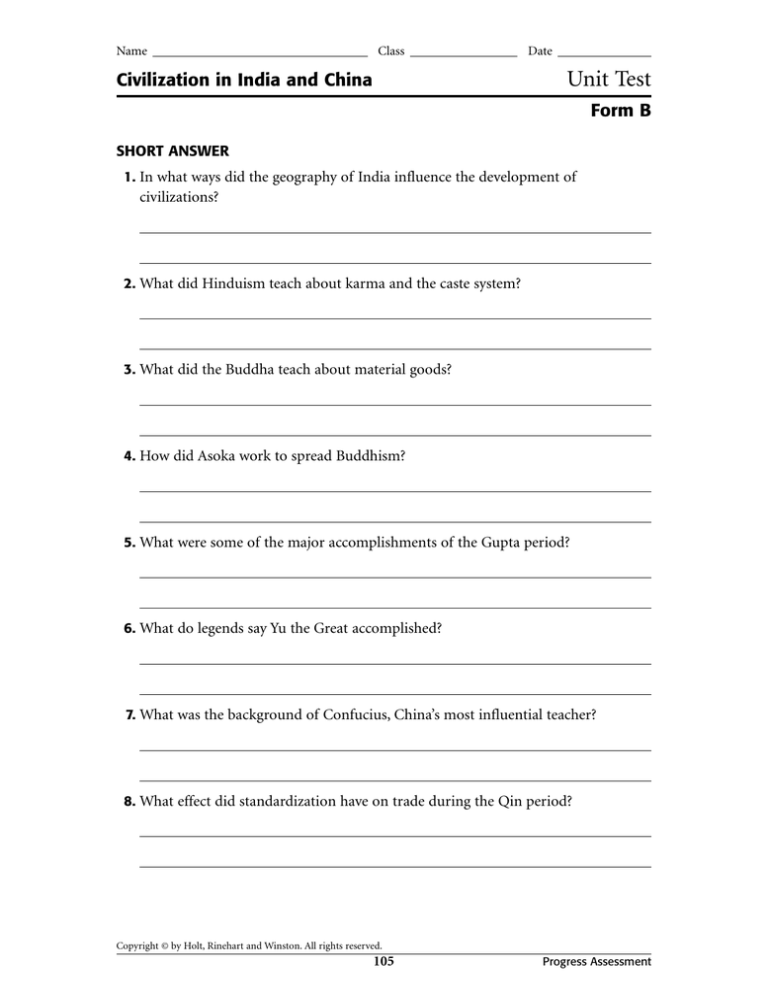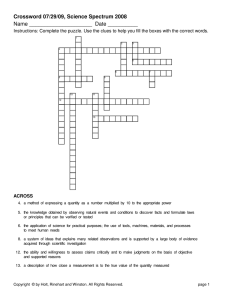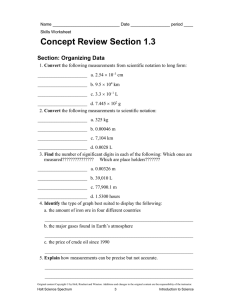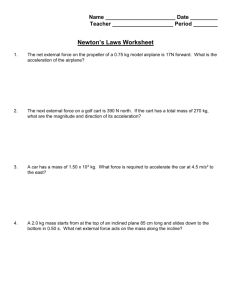
Name
Class
Date
Unit Test
Civilization in India and China
Form B
SHORT ANSWER
1. In what ways did the geography of India influence the development of
civilizations?
2. What did Hinduism teach about karma and the caste system?
3. What did the Buddha teach about material goods?
4. How did Asoka work to spread Buddhism?
5. What were some of the major accomplishments of the Gupta period?
6. What do legends say Yu the Great accomplished?
7. What was the background of Confucius, China’s most influential teacher?
8. What effect did standardization have on trade during the Qin period?
Copyright © by Holt, Rinehart and Winston. All rights reserved.
105
Progress Assessment
Name
Class
Civilization in India and China, continued
Date
Unit Test Form B
9. What kind of government did Wudi want to create?
10. Why was revealing the secret to making silk punishable by death?
Copyright © by Holt, Rinehart and Winston. All rights reserved.
106
Progress Assessment
Name
Class
Civilization in India and China, continued
Date
Unit Test Form B
PRACTICING SOCIAL STUDIES SKILLS
Study the maps below and answer the questions that follow.
11. Would you expect to find more Buddhists in India or Sumatra? Explain your
answer.
Copyright © by Holt, Rinehart and Winston. All rights reserved.
107
Progress Assessment
Name
Class
Civilization in India and China, continued
Date
Unit Test Form B
12. Explain how flooding could have been a major problem to the Shang dynasty.
Copyright © by Holt, Rinehart and Winston. All rights reserved.
108
Progress Assessment
Answer Key
TRUE/FALSE
10. The countries were sometimes at war.
Egypt invaded Kush, and the Kushites later
revolted and gained their independence.
Still, the Kushites kept many of the
Egyptian ways they had adopted. Kush
and Egypt were also trading partners.
1.
2.
3.
4.
5.
F
F
T
F
F
PRACTICING SOCIAL STUDIES SKILLS
MATCHING
11. People might not have been able to grow
1.
2.
3.
4.
5.
6.
7.
8.
9.
10.
crops to eat in the Syrian Desert.
12. Ugarit
13. People in Byblos probably traded timber
for gold from Punt.
Unit Test Civilization in
India and China Form A
MULTIPLE CHOICE
1.
2.
3.
4.
5.
6.
7.
8.
9.
10.
D
D
C
A
B
C
B
A
A
D
11.
12.
13.
14.
15.
16.
17.
18.
19.
20.
C
B
D
A
D
D
A
D
C
B
T
T
F
F
F
11.
12.
13.
14.
15.
16.
17.
18.
19.
20.
R
T
O
Q
D
L
J
I
X
N
Unit Test Civilization in
India and China Form B
SHORT ANSWER
1. The flooding of the Indus River Valley
2.
PRACTICING SOCIAL STUDIES SKILLS
21. C
22. D
3.
COMPLETION
1.
2.
3.
4.
5.
6.
7.
8.
9.
10.
Z
S
F
G
K
C
V
B
A
E
6.
7.
8.
9.
10.
Aryans
reaction to
not important
began to decline
still important
writing
Legalism
Trade
daily activities
helped
4.
5.
6.
created fertile areas where farmers could
settle. The Himalayas protected early
civilizations from most invaders.
According to Hinduism, a person who
lives a good life builds up good karma and
can be reborn into a higher caste.
The Buddha believed that suffering came
from people desiring material goods that
they did not have, and that they should
learn to overcome this desire.
Asoka sent missionaries around Asia to
teach people about Buddhism, and he
had columns built that were carved with
Buddhist teachings.
During the Gupta period, architecture
became more complex, great paintings
and sculptures were created, and new
ideas in math and medicine were
developed.
Yu founded the Xia dynasty. He dug
channels to drain water to the ocean after
terrible floods, and created the waterways
in northern China.
Copyright © by Holt, Rinehart and Winston. All rights reserved.
378
Progress Assessment
Answer Key
COMPLETION
7. Confucius was born in poverty but was
able to learn about many subjects. He
worked in the government and then as a
teacher.
8. When writing systems and different
measurements were standardized, it
became easier for people in different
regions to trade with each other.
9. Wudi wanted a strong central government
with a policy of Confucianism, where
people got jobs based on ability.
10. Trading silk with other regions made
China wealthy. If others learned how to
make silk, it would not be as valuable.
1.
2.
3.
4.
5.
6.
7.
8.
9.
10.
TRUE/FALSE
1.
2.
3.
4.
5.
PRACTICING SOCIAL STUDIES SKILLS
11. There are probably more Buddhists in
India, because it was closer to the area
where Buddhism started.
12. The major cities are located near the
Huang He River, and could have been
destroyed by major floods.
1.
2.
3.
4.
5.
6.
7.
8.
9.
10.
MULTIPLE CHOICE
D
B
A
A
C
D
A
D
B
A
11.
12.
13.
14.
15.
16.
17.
18.
19.
20.
F
T
T
F
F
6.
7.
8.
9.
10.
T
T
F
T
F
11.
12.
13.
14.
15.
16.
17.
18.
19.
20.
L
Y
N
D
Z
O
S
I
M
B
MATCHING
Unit Test Foundation of
Western Ideas Form A
1.
2.
3.
4.
5.
6.
7.
8.
9.
10.
Ruth
Tanach
Yiddish
Mycenaeans
sun
Iliad
roads
Delian
Hellenistic
Socrates
A
D
B
D
C
C
B
D
A
B
Q
T
K
H
E
F
R
W
U
G
Unit Test Foundation of
Western Ideas Form B
SHORT ANSWER
1. Jews believe in teaching children the basics
of Judaism and expect both boys and girls
to study these beliefs today.
2. The Ten Commandments state ten moral
laws. By accepting these moral laws, the
Hebrews promised to worship only one
God as well as agree to other moral laws
outlining murder, adultery, and envy.
3. Jewish people today celebrate Hanukkah
in December every year and Passover in
March or April each year. Also celebrated
by Jewish people are the High Holy Days,
which help today’s Jews feel more connected to their past.
PRACTICING SOCIAL STUDIES SKILLS
21. C
22. B
Copyright © by Holt, Rinehart and Winston. All rights reserved.
379
Progress Assessment






